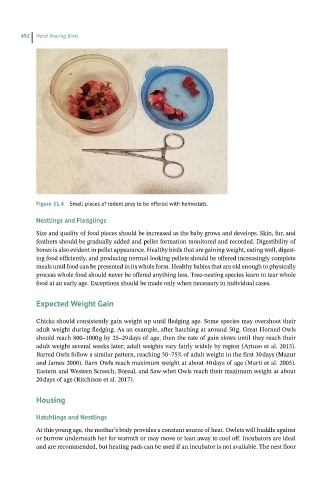Page 496 - Hand rearing birds second
P. 496
492 Hand-Rearing Birds
Figure31.4 Small pieces of rodent prey to be offered with hemostats.
Nestlingsand Fledglings
Size and quality of food pieces should be increased as the baby grows and develops. Skin, fur, and
feathers should be gradually added and pellet formation monitored and recorded. Digestibility of
bones is also evident in pellet appearance. Healthy birds that are gaining weight, eating well, digest-
ing food efficiently, and producing normal‐looking pellets should be offered increasingly complete
meals until food can be presented in its whole form. Healthy babies that are old enough to physically
process whole food should never be offered anything less. Tree‐nesting species learn to tear whole
food at an early age. Exceptions should be made only when necessary in individual cases.
ExpectedWeightGain
Chicks should consistently gain weight up until fledging age. Some species may overshoot their
adult weight during fledging. As an example, after hatching at around 50 g, Great Horned Owls
should reach 800–1000 g by 25–29 days of age, then the rate of gain slows until they reach their
adult weight several weeks later; adult weights vary fairly widely by region (Artuso et al. 2013).
Barred Owls follow a similar pattern, reaching 50–75% of adult weight in the first 30 days (Mazur
and James 2000). Barn Owls reach maximum weight at about 40 days of age (Marti et al. 2005).
Eastern and Western Screech, Boreal, and Saw‐whet Owls reach their maximum weight at about
20 days of age (Ritchison et al. 2017).
Housing
Hatchlingsand Nestlings
At this young age, the mother’s body provides a constant source of heat. Owlets will huddle against
or burrow underneath her for warmth or may move or lean away to cool off. Incubators are ideal
and are recommended, but heating pads can be used if an incubator is not available. The nest floor

